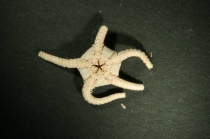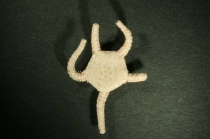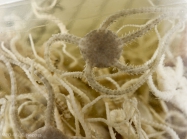WoRMS taxon details
Ophiura robusta (Ayres, 1852)
124933 (urn:lsid:marinespecies.org:taxname:124933)
accepted
Species
Ophioglypha robusta (Ayres, 1854) · unaccepted (superceded combination)
Ophiolepis robusta Ayres, 1852 · unaccepted (synonym)
Ophiura fasciculata Forbes, 1852 · unaccepted (synonym)
Ophiura squamosa Lütken, 1855 · unaccepted (synonymized by Mortensen (1927))
marine, brackish, fresh, terrestrial
(of Ophiolepis robusta Ayres, 1852) Ayres, W.O. (1852). An account of the structure of the Ophiuridae and a description and drawings of a new species belonging to the genus Ophiolepis. <em>Proceedings Boston Society Natural History.</em> 4: 133-135., available online at https://www.biodiversitylibrary.org/page/8870843
page(s): 134 [details]
page(s): 134 [details]
Taxonomy O. robusta has a hook-shaped middle spine on distal arm segments. This character is unusual in Ophiura and my suggest that...
Distribution In depths of more than 40 m, on rougher ground than other Ophiura species, off the northeast coast of Britain, occasional...
Distribution Gulf of St. Lawrence (unspecified region), Saguenay Fjord, northern Gaspe waters, southern Gaspe waters (Baie des Chaleurs,...
Taxonomy O. robusta has a hook-shaped middle spine on distal arm segments. This character is unusual in Ophiura and my suggest that the species belongs in a different genus, possibly Ophiuroglypha. [details]
Distribution In depths of more than 40 m, on rougher ground than other Ophiura species, off the northeast coast of Britain, occasional...
Distribution In depths of more than 40 m, on rougher ground than other Ophiura species, off the northeast coast of Britain, occasional in the northern North Sea [details]
Distribution Gulf of St. Lawrence (unspecified region), Saguenay Fjord, northern Gaspe waters, southern Gaspe waters (Baie des Chaleurs,...
Distribution Gulf of St. Lawrence (unspecified region), Saguenay Fjord, northern Gaspe waters, southern Gaspe waters (Baie des Chaleurs, Gaspe Bay to American, Orphan and Bradelle banks; eastern boundary: eastern Bradelle valley), downstream part of middle St. Lawrence estuary, lower St. Lawrence estuary, Magdalen Islands (from eastern Bradelle valley to the west, as far as Cape North, including the Cape Breton Channel), Prince Edward Island (from the northern tip of Miscou Island, N.B. to Cape Breton Island south of Cheticamp, including the Northumberland Strait and Georges Bay to the Canso Strait causeway), middle North Shore (from Sept- Iles to Cape Whittle, including the Mingan Islands), Laurentian Channel (bathyal zone)(=Honguedo Strait), lower North Shore, North and South slope of Anticosti Island; western slope of Newfoundland, including the southern part of the Strait of Belle Isle but excluding the upper 50m in the area southwest of Newfoundland; Cape Hatteras [details]
Stöhr, S.; O’Hara, T.; Thuy, B. (Eds) (2024). World Ophiuroidea Database. Ophiura robusta (Ayres, 1852). Accessed through: World Register of Marine Species at: https://www.marinespecies.org/aphia.php?p=taxdetails&id=124933 on 2024-09-21
Date
action
by
![]() The webpage text is licensed under a Creative Commons Attribution 4.0 License
The webpage text is licensed under a Creative Commons Attribution 4.0 License
original description
(of Ophiolepis robusta Ayres, 1852) Ayres, W.O. (1852). An account of the structure of the Ophiuridae and a description and drawings of a new species belonging to the genus Ophiolepis. <em>Proceedings Boston Society Natural History.</em> 4: 133-135., available online at https://www.biodiversitylibrary.org/page/8870843
page(s): 134 [details]
original description (of Ophiura fasciculata Forbes, 1852) Forbes, E. (1852). Notes on animals of the class Echinodermata collected by Dr. Sutherland in Assistance Bay. In Sutherland, P.C. Journal of a voyage in Baffin's Bay and Barrow Straits in the years 1850-1851 performed by KM. Ships 'Lady Franklin'and 'Sophia. II: appendix ccxiv-ccxvi., available online at https://archive.org/details/cihm_40908 [details]
original description (of Ophiura squamosa Lütken, 1855) Lütken, C.F. (1855). Bidrag til Kundskab om Slangestjernerne. I. Forelöbig Oversigt over Grönlandshavets Ophiurer. <em>Videnskabelige Meddelelser fra den naturhistoriske Forening 1854-.</em> 6: 95-104., available online at https://www.biodiversitylibrary.org/page/35632675#page/99/mode/1up
page(s): 100 [details]
context source (Deepsea) Smirnov I.S., Piepenburg D., Ahearn C., Juterzenka K.V. (2014). Deep-sea fauna of European seas: An annotated species check-list of benthic invertebrates living deeper than 2000 m in the seas bordering Europe. Ophiuroidea. <i>Invertebrate Zoology</i>. Vol.11. No.1: 192–209 [in English]. [details] Available for editors [request]
[request]
basis of record Hansson, H.G. (2001). Echinodermata, <B><I>in</I></B>: Costello, M.J. <i>et al.</i> (Ed.) (2001). <i>European register of marine species: a check-list of the marine species in Europe and a bibliography of guides to their identification. Collection Patrimoines Naturels,</i>. 50: pp. 336-351. (look up in IMIS) [details]
additional source Brunel, P., L. Bosse & G. Lamarche. (1998). Catalogue of the marine invertebrates of the estuary and Gulf of St. Lawrence. <em>Canadian Special Publication of Fisheries and Aquatic Sciences, 126.</em> 405 pp. (look up in IMIS) [details] Available for editors [request]
[request]
additional source Gosner, 1977 [details]
additional source Linkletter, L. E. (1977). A checklist of marine fauna and flora of the Bay of Fundy. <em>Huntsman Marine Laboratory, St. Andrews, N.B.</em> 68: p. [details]
additional source Southward, E.C.; Campbell, A.C. (2006). [Echinoderms: keys and notes for the identification of British species]. <i>Synopses of the British fauna (new series)</i>, 56. Field Studies Council: Shrewsbury, UK. ISBN 1-85153-269-2. 272 pp. (look up in IMIS) [details]
additional source Thuy, B.; Stöhr, S. (2011). Lateral arm plate morphology in brittle stars (Echinodermata: Ophiuroidea): new perspectives for ophiuroid micropalaeontology and classification. <em>Zootaxa.</em> 3013, 1-47.
note: The hook-shaped arm spines are shown for the first time in this publication. [details]
additional source Integrated Taxonomic Information System (ITIS). , available online at http://www.itis.gov [details]
additional source Hansson, H. (2004). North East Atlantic Taxa (NEAT): Nematoda. Internet pdf Ed. Aug 1998., available online at http://www.tmbl.gu.se/libdb/taxon/taxa.html [details] Available for editors [request]
[request]
page(s): 134 [details]
original description (of Ophiura fasciculata Forbes, 1852) Forbes, E. (1852). Notes on animals of the class Echinodermata collected by Dr. Sutherland in Assistance Bay. In Sutherland, P.C. Journal of a voyage in Baffin's Bay and Barrow Straits in the years 1850-1851 performed by KM. Ships 'Lady Franklin'and 'Sophia. II: appendix ccxiv-ccxvi., available online at https://archive.org/details/cihm_40908 [details]
original description (of Ophiura squamosa Lütken, 1855) Lütken, C.F. (1855). Bidrag til Kundskab om Slangestjernerne. I. Forelöbig Oversigt over Grönlandshavets Ophiurer. <em>Videnskabelige Meddelelser fra den naturhistoriske Forening 1854-.</em> 6: 95-104., available online at https://www.biodiversitylibrary.org/page/35632675#page/99/mode/1up
page(s): 100 [details]
context source (Deepsea) Smirnov I.S., Piepenburg D., Ahearn C., Juterzenka K.V. (2014). Deep-sea fauna of European seas: An annotated species check-list of benthic invertebrates living deeper than 2000 m in the seas bordering Europe. Ophiuroidea. <i>Invertebrate Zoology</i>. Vol.11. No.1: 192–209 [in English]. [details] Available for editors
basis of record Hansson, H.G. (2001). Echinodermata, <B><I>in</I></B>: Costello, M.J. <i>et al.</i> (Ed.) (2001). <i>European register of marine species: a check-list of the marine species in Europe and a bibliography of guides to their identification. Collection Patrimoines Naturels,</i>. 50: pp. 336-351. (look up in IMIS) [details]
additional source Brunel, P., L. Bosse & G. Lamarche. (1998). Catalogue of the marine invertebrates of the estuary and Gulf of St. Lawrence. <em>Canadian Special Publication of Fisheries and Aquatic Sciences, 126.</em> 405 pp. (look up in IMIS) [details] Available for editors
additional source Gosner, 1977 [details]
additional source Linkletter, L. E. (1977). A checklist of marine fauna and flora of the Bay of Fundy. <em>Huntsman Marine Laboratory, St. Andrews, N.B.</em> 68: p. [details]
additional source Southward, E.C.; Campbell, A.C. (2006). [Echinoderms: keys and notes for the identification of British species]. <i>Synopses of the British fauna (new series)</i>, 56. Field Studies Council: Shrewsbury, UK. ISBN 1-85153-269-2. 272 pp. (look up in IMIS) [details]
additional source Thuy, B.; Stöhr, S. (2011). Lateral arm plate morphology in brittle stars (Echinodermata: Ophiuroidea): new perspectives for ophiuroid micropalaeontology and classification. <em>Zootaxa.</em> 3013, 1-47.
note: The hook-shaped arm spines are shown for the first time in this publication. [details]
additional source Integrated Taxonomic Information System (ITIS). , available online at http://www.itis.gov [details]
additional source Hansson, H. (2004). North East Atlantic Taxa (NEAT): Nematoda. Internet pdf Ed. Aug 1998., available online at http://www.tmbl.gu.se/libdb/taxon/taxa.html [details] Available for editors
 Present
Present  Present in aphia/obis/gbif/idigbio
Present in aphia/obis/gbif/idigbio  Inaccurate
Inaccurate  Introduced: alien
Introduced: alien  Containing type locality
Containing type locality
From editor or global species database
Taxonomy O. robusta has a hook-shaped middle spine on distal arm segments. This character is unusual in Ophiura and my suggest that the species belongs in a different genus, possibly Ophiuroglypha. [details]From other sources
Authority Ayres, 1851 [details]Breeding Ophiopluteus larva. April-May [details]
Distribution In depths of more than 40 m, on rougher ground than other Ophiura species, off the northeast coast of Britain, occasional in the northern North Sea [details]
Distribution Gulf of St. Lawrence (unspecified region), Saguenay Fjord, northern Gaspe waters, southern Gaspe waters (Baie des Chaleurs, Gaspe Bay to American, Orphan and Bradelle banks; eastern boundary: eastern Bradelle valley), downstream part of middle St. Lawrence estuary, lower St. Lawrence estuary, Magdalen Islands (from eastern Bradelle valley to the west, as far as Cape North, including the Cape Breton Channel), Prince Edward Island (from the northern tip of Miscou Island, N.B. to Cape Breton Island south of Cheticamp, including the Northumberland Strait and Georges Bay to the Canso Strait causeway), middle North Shore (from Sept- Iles to Cape Whittle, including the Mingan Islands), Laurentian Channel (bathyal zone)(=Honguedo Strait), lower North Shore, North and South slope of Anticosti Island; western slope of Newfoundland, including the southern part of the Strait of Belle Isle but excluding the upper 50m in the area southwest of Newfoundland; Cape Hatteras [details]
Habitat intertidal, bathyal, infralittoral and circalittoral of the Gulf and estuary [details]
| Language | Name | |
|---|---|---|
| Norwegian Bokmål | nordlig slangestjerne | [details] |
| Norwegian Nynorsk | nordleg slangestjerne | [details] |
| Swedish | mindre fransormstjärna | [details] |
To Barcode of Life (42 barcodes)
To Biodiversity Heritage Library (1 publication) (from synonym Ophioglypha robusta (Ayres, 1854))
To Biodiversity Heritage Library (14 publications) (from synonym Ophiura fasciculata Forbes, 1852)
To Biodiversity Heritage Library (20 publications) (from synonym Ophiolepis robusta Ayres, 1852)
To Biodiversity Heritage Library (27 publications) (from synonym Ophiura squamosa Lütken, 1855)
To Biodiversity Heritage Library (49 publications)
To Dyntaxa
To European Nucleotide Archive, ENA (Ophiura robusta)
To GenBank (5 nucleotides; 5 proteins)
To Global Biotic Interactions (GloBI)
To Macrozoobenthos communities of Svalbard
To PESI
To PESI (from synonym Ophiolepis robusta Ayres, 1852)
To PESI (from synonym Ophiura fasciculata Forbes, 1852)
To PESI (from synonym Ophiura squamosa Lütken, 1855)
To The Arctic Traits Database (28 traits)
To USNM Invertebrate Zoology Echinodermata Collection (231 records)
To Yale Peabody Museum of Natural History (YPM IZ 002319.EC)
To ITIS
To Biodiversity Heritage Library (1 publication) (from synonym Ophioglypha robusta (Ayres, 1854))
To Biodiversity Heritage Library (14 publications) (from synonym Ophiura fasciculata Forbes, 1852)
To Biodiversity Heritage Library (20 publications) (from synonym Ophiolepis robusta Ayres, 1852)
To Biodiversity Heritage Library (27 publications) (from synonym Ophiura squamosa Lütken, 1855)
To Biodiversity Heritage Library (49 publications)
To Dyntaxa
To European Nucleotide Archive, ENA (Ophiura robusta)
To GenBank (5 nucleotides; 5 proteins)
To Global Biotic Interactions (GloBI)
To Macrozoobenthos communities of Svalbard
To PESI
To PESI (from synonym Ophiolepis robusta Ayres, 1852)
To PESI (from synonym Ophiura fasciculata Forbes, 1852)
To PESI (from synonym Ophiura squamosa Lütken, 1855)
To The Arctic Traits Database (28 traits)
To USNM Invertebrate Zoology Echinodermata Collection (231 records)
To Yale Peabody Museum of Natural History (YPM IZ 002319.EC)
To ITIS





